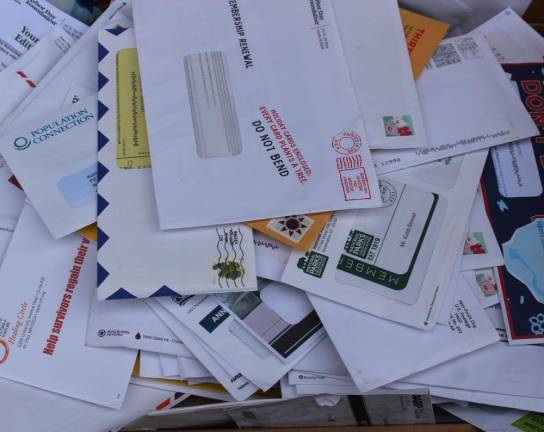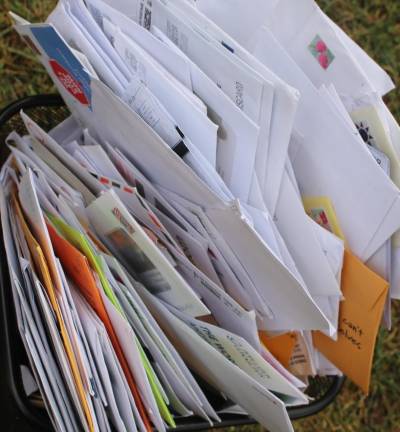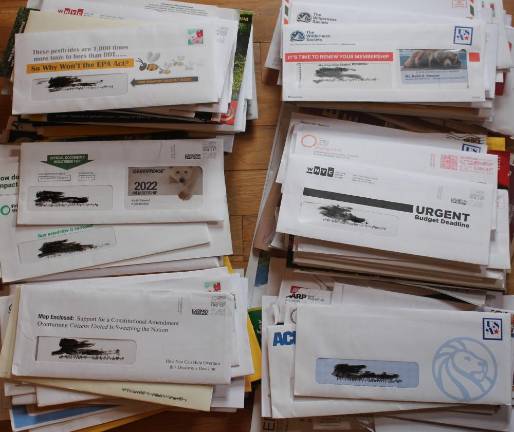Killing me slowly with junk mail
A Sisyphean journey to dig out from under the relentless pile



I’m overwhelmed with junk mail — especially the stuff sent by non-profit organizations I want to support. I’m betting you are too: 66.2 billion pieces of unsolicited mail were sent by the United States Postal Service in 2021, which works out to more than 250 pieces to every American adult.
In my case, most of it comes, ironically, from nonprofits that work to protect wilderness areas, wildlife, clean air, clean water — good causes, if you happen to have an environmental turn of mind. The problem is that once I’ve donated $50 or $100, many of these oft-heralded environmental defenders attach themselves to me like leaches that need continuous feeding. They bombard me with so many solicitations that my mailbox, unless emptied daily, soon becomes jam-packed.
Any one of these earth champions might send 15 or 20 solicitations in a single year. To encourage me to donate, or perhaps to feel guilty if I don’t, they often send gifts that I neither need nor want — calendars, notepads, greeting cards, address labels (already, I have enough address labels to last several lifetimes). These “free gifts” are just more clutter. But what really bothers me is that all this paper, cardboard and ink is one more blight we humans impose upon the planet.
Does anyone actually like all this mail? The United States Postal Service does, for one, and has courted lucrative “direct mail” business to shore up its faltering bottom line for at least a decade.
For sure, junk mail is not as bad as plastic bags, but it is a massive pile of stuff, most of which ends up in landfills. Equally alarming is the great number of trees felled annually (about 100 million) to satisfy the paper-guzzling, water-consuming, CO2-belching, fundraising industry. It’s a behemoth of waste and pollution.
How can groups that sincerely want to be good stewards of the planet be so profligate with our increasingly scarce natural resources? I understand their need to raise money to stay afloat and do their important work, but surely there is a better way.
After enduring junk mail overload for too long, in 2021, I came up with a plan. For the first eleven-and-a-half months of the year, I tossed all fundraising mail, unopened, into a large cardboard box. In mid-December, when I usually make charitable donations, I counted and sorted the contents of the box. More than 300 envelopes or packages were sent by some 50 different groups. Nine groups sent between 10 and 20 requests during the year. One had the gall to send 23. More average tallies were three or four per group. I’m not counting the junk mail addressed to my wife. She has her own preferred causes and receives her own slew of unwanted solicitations but, unlike me, she throws them out as fast as they come in. Still, they clog the PO box we share.
Looking over all the solicitation mail I received in 2021 gave me a few insights into the fundraising business. Larger groups with national profiles generally sent more requests for donations than smaller, regional or local groups. They also sent more glossy pictures, unneeded gifts, newsletters, and surveys. By the way, I do not contribute to 50 organizations a year. Ask anyone who knows me, I’m not that generous. At most, I’ve given to around 20. This means that 30 groups I’ve never supported believe I might be a good prospect. Why? After a little online research, I confirmed what I more or less understood for a long time — many nonprofits routinely share or rent their donor names and addresses with other groups that have a similar mission. This may work for them, but, to me, it smells like a betrayal of trust and recalls the proverb, “no good deed goes unpunished.” It does not inspire loyalty.
In December of 2021, I donated to most of the groups I had supported in the past. Along with a check, I enclosed a letter to the president or CEO of each high-soliciting group, explaining how I felt about their barrage of mail and its environmental cost. I said, unless they can find a way to limit their fundraising mail, I would probably stop donating to them. One small nonprofit responded, saying they would do as I asked. The others declined to answer directly, but over the course of 2022 their number of solicitations stayed the same or increased.
This past December, I stopped giving to the most egregious senders. Again, I enclosed letters explaining my position. Again, they seem to make no impression. I’m guessing the people who open mail and process checks are pigeon-holed into that work and not tasked with anything else. They probably considered my letter junk mail.
My current plan of attack:
It turns out there are online tools to reduce the flow to your mailbox. A $4 fee to DMAChoice.org, one of the top mailing list providers, gets you the privilege of being taken off their list. Catalogchoice.org, a nonprofit that works to end junk mail, opts you out of catalogs of your choosing for no charge.
But as a pre-Boomer* who’s never felt at home in the cyber world, I’m taking a different tack. It involves the telephone! After expressing my exasperation to staff in the fundraising departments of a few of my preferred nonprofits, I’ve learned that donors can ask to be put on a “one solicitation per year” list. This means, at least theoretically, you’ll receive only a year-end membership renewal letter. You can also ask to be put on a “no-share” list, which should stop the flow of solicitations from groups you’ve never given to, though those that already have your name will probably keep sending mail unless you tell them not to. Yes, all this telephoning will take time and probably cause some frustration, but I’m willing to do it. Dealing with junk mail also takes time. And it’s a downer.
Earthjustice is an environmental law organization that uses the law to fight climate change, advance clean energy, and protect wildlife, open spaces and human health. They have more than 200 attorneys and 15 regional offices in the U.S. I’ve contributed to Earthjustice for several years. To their credit, they sent me only three solicitation letters in 2022. But I called them anyway and spoke with Outreach and Member Services Manager Tatianna Peck. She was sympathetic with my concerns and quickly moved my name to the “one solicitation per year” and “no-share” lists. She also assured me that Earthjustice is constantly grappling with ways to streamline fundraising and reduce paper flow. Most of their donations still come by check or credit card. But they are working to expand digital fundraising via their website, emails and social media. This would greatly reduce paper flow. It gives me hope.
* From my willingness to write complaining articles you might not guess it, but I’m actually from the Silent Generation (1928-45), born March, 1944.